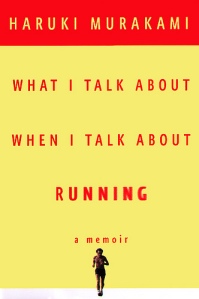What I Talk About When I Talk About Running: A Memoir
 By Haruki Murakami
By Haruki Murakami
Published July 29, 2008
175 pp.
ISBN 0-307-26919-1
Reviewed March 29, 2009
In the bookstore there are always a few authors who have written enough well-received titles that they earn their own style of mass-market paperback, covers showcasing the same design and decorated with a variety of gushing quotes. Kurt Vonnegut has two colors and a V overlapped with name and title, while Christopher Moore has fanciful fonts and often macabre images in the middle of the front cover. The idea is of course to get you to buy all the titles, thus giving your bookshelf a feeling of accomplishment. (And in Vonnegut’s case, it works on me.)
But every so often an author deviates from this format, usually for smaller pieces or when they start writing about themselves. Haruki Murakami is the most recent of the notables, with his latest title “What I Talk About When I Talk About Running” exchanging the abstract artwork and eye images for a small image of himself pounding down the road. Design is one of three things setting it apart from his other works, in addition to it being a personal memoir and unfortunately not as engrossing as previous works.
Murakami, author of the critically acclaimed works “Norwegian Wood” and “Kafka on the Shore,” began running in 1982 to keep in shape as he changed careers from jazz club owner to novelist. Since then he has been running consistently for 27 years, participating in marathons and triathlons from New York City to Tokyo. “Running” goes over his experiences of training and running, the positive and negative effects it has on his body and its relation to life and writing.
Murakami’s career has been built on writing books that capture a bittersweet, emotional attitude in everyday life, with a postmodern writing style that uses both humor and surrealism to bring the themes across. In comparison, “Running” is a much more straightforward book, more like a journal than a story and frequently discoursing on the various sights and experiences he sees on his treks. It’s a straightforwardness that – surprisingly – borders on mundane, lacking the emotional center of his other works (or even other memoirs I’ve reviewed).
The chief issue with this could be that the book is a translation, originally written in Murakami’s native Japanese. Murakami even hints at such a problem when he speaks of how he has a “tight” relationship with Japanese, and it is in that language he best catches hold of words and context. As he is writing about himself – a deeply personal topic – he may have more to say in his native language that does not lend itself to conversion, regardless of how skilled translator Philip Gabriel is.
Of course, the problem may lay with the author himself as much as his language. At multiple points in “Running” Murakami seems startlingly self-conscious, clarifying that he is a person who likes to be left alone, and frequently has to excuse himself with phrases like “As I mentioned earlier…” He also clarifies in the introduction that “Running” is more of a gathering of thought, written in a “real time” form and reprinting some old articles, so by definition it will be a bit haphazard. There’s not a real chronology to the book, and he tends to jump from race to race without mentioning the outcome of some marathons.
Despite these criticisms, “Running” is certainly not a bad book. While Murakami makes note of being a private person he does have quite a bit to say about his past, talking about his relationship with his wife and the jazz club he ran prior to becoming a writer. He also takes the time to discuss the writing process, and the epiphany at a baseball game that he could try writing a novel (which seems a bit anticlimactic, but the setting is described with such feeling it’s hard not to get caught up).
At some points Murakami seems to forget himself in both the acts of running and writing, describing the motion of his limbs and the feel of the ground underneath his reliable jogging shoes. In these cases, the passages have echoes of his fiction, the same control of evocative prose: “My silent heart expanded and contracted, over and over at a fixed rate. Like the bellows of a worker, the lungs faithfully brought fresh oxygen into my body.” The writing is best when he dwells on these moments, rather than which Rolling Stones album he plays on longer jogs.
For people who have never read Murakami before, this book isn’t the best introduction – I personally recommend “Norwegian Wood” for that – but it’s a serviceable book for people who are either interested in running or learning about Murakami as a person. His enthusiasm for the act of running and the positive impact it has had on him personally is certainly noticeable, but for some reason he can’t capture his life as poetically as his characters.



 Posted by Les Chappell
Posted by Les Chappell